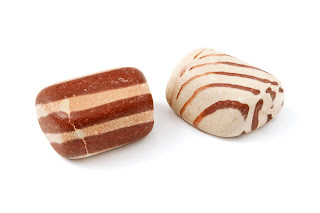One of the things I was glad to get at the show in Arizona was Zebra Rock. I'd seen it around for a few years and while I'd bought a piece for myself, I'd thought it too expensive to work in the shop. Last year I noticed some at a far more reasonable price and gave it a go - lots of little tumblestone-sized pieces and a few larger lumps. It went very well. This year I couldn't find exactly the same stuff, but the seller told me he had a lot of rough material at another venue. A couple of days later I found it, and picked out a few kilos from a huge barrel. I'll need to wash it and sand it down a little, but the extra effort will be well worth it.
It's unusual stuff, and there has been a lot of discussion on exactly how it formed. It was first found in Argyle Station, in East Kimberley, Western Australia in the 1920s by a geologist visiting from New York. This locality is now under reservoir water and more sources have been found nearby - the stuff I have is from Kununurra, a little further North.
It's a silicious argillite - that's clay or siltstone with quartz and is pre-Cambrian in age; over 600 million years old. What makes it special, though, is its amazing banding pattern. It varies from spots to (more frequently) stripes but usually surprisingly regular. It looks like it has been hand-painted. These bands and how they were formed is the subject for debate. Originally it had been thought that it was the result of deformation of original sedimentary layers, or possibly the introduction of an iron-rich mineral into a pale clay. The grain-size and texture is consistent across the pattern, though, which would suggest the first of these is unlikely and the structure of the patterning provides difficulties for the second. What seems the most plausible explanation is that hematite-rich bands are the result of a hydrothermal precipitation of sorts - mineral-saturated water moving through the body of rock distributing iron-rich patches as it built sufficient concentration. This paper provides a better explanation than I can, and looks at the part magnetism may have played. Be warned - it's complimacated and has far more words than pictures. It's enough for me - and most others - that it looks nice.

No comments:
Post a Comment